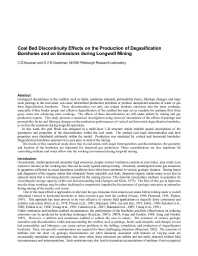Mining Publication: Coal Bed Discontinuity Effects on the Production of Degasification Boreholes and on Emissions During Longwall Mining
Original creation date: October 2008
Geological discontinues in the coalbed, such as faults, sandstone channels, permeability facies, lithotype changes, and large scale partings in the coal seam, can cause intermittent production problems or produce unexpected amounts of water or gas from degasification boreholes. These discontinuities not only can impact methane emissions into the mine workings, especially if they hinder proper and effective degasification of the coalbed but may act as conduits for methane flow from gassy strata into advancing mine workings. The effects of these discontinuities are still under debate by mining and gas production experts. This study presents a numerical investigation using reservoir simulations of the effects of partings and permeability facies and lithotype changes on the production performances of vertical and horizontal degasification boreholes, as well as the emissions during longwall operations. In this work, the grid block was designed in a multi-layer 3-D structure which enabled spatial descriptions of the geometries and properties of the discontinuities within the coal seam. The studied coal seam discontinuities and their properties were distributed arbitrarily within the model. Production was simulated by vertical and horizontal boreholes. Degasification boreholes operated two years prior to start of the mining. The results of this numerical study show that in coal seams with major heterogeneities and discontinuties, the geometry and location of the boreholes are important for improved gas production. These considerations are also important for controlling methane and water inflow into the working environment during longwall mining.
Authors: CÖ Karacan, GV Goodman
Conference Paper - October 2008
NIOSHTIC2 Number: 20034633
SPE Eastern Regional/AAPG Eastern Section Joint Meeting, 11-15 October 2008, Pittsburgh, Pennsylvania, USA, SPE 117215. Richardson, TX: Society of Petroleum Engineers, 2008; :1-13
See Also
- A CART Technique to Adjust Production from Longwall Coal Operations under Ventilation Constraints
- Coal Mine Methane: A Review of Capture and Utilization Practices with Benefits to Mining Safety and to Greenhouse Gas Reduction
- Degasification System Selection for U.S. Longwall Mines Using an Expert Classification System
- Historical Development of Technologies for Controlling Methane in Underground Coal Mines
- MCP - Methane Control and Prediction - 2.0
- Methane Control by Isolation of a Major Coal Panel - Pittsburgh Coalbed
- Methane Emission Rate Studies in a Central Pennsylvania Mine
- Prediction of Longwall Methane Emissions and the Associated Consequences of Increasing Longwall Face Lengths: A Case Study in the Pittsburgh Coalbed
- Rotary Drilling Techniques Used in the Beckley Coalbed
- Underground Gob Gas Drainage During Longwall Mining
- Page last reviewed: 9/21/2012
- Page last updated: 9/21/2012
- Content source: National Institute for Occupational Safety and Health, Mining Program


 ShareCompartir
ShareCompartir
